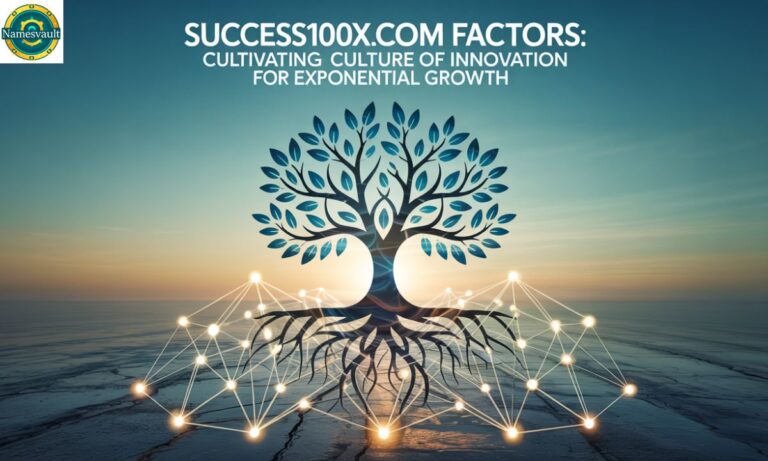Innovation drives progress. Without it, businesses fall behind. The Success100x.com Factors help create a culture where ideas grow. In today’s world, adaptability is power. A strong innovation culture builds the path to exponential growth.
What Is a Culture of Innovation and Why It Matters
A culture of innovation encourages curiosity, experimentation, and creative problem-solving. It’s more than just a buzzword—it’s a mindset that drives progress. Organizations that nurture this culture outperform those that resist change.
Innovation helps companies stay competitive and relevant. As industries evolve, businesses must adapt quickly. A workplace culture built around innovation enables continuous improvement across all departments.
Companies that invest in innovation see higher employee engagement, better products, and improved customer experiences. This culture is not reserved for tech giants—any organization can build it with the right framework.
How Success100x.com Factors Drive Business Growth
The Success100x.com Factors are foundational elements that ignite sustainable business success. These principles align employees with organizational goals while encouraging bold thinking.
When innovation becomes a daily practice, companies gain a clear edge. They respond faster to market changes and capitalize on new opportunities. This accelerates growth and builds resilience.
By adopting the Success100x.com model, businesses experience increased productivity, creativity, and profitability. It’s a proven system for turning ideas into results.
Building Innovation Through a Growth Mindset
A growth mindset is the belief that skills and intelligence can be developed. This mindset encourages risk-taking and learning from failure, which are critical for innovation.
Employees with a growth mindset embrace challenges. They are not afraid to fail—they see mistakes as chances to improve. This leads to more experimentation and better outcomes.
Organizations that foster a growth mindset attract top talent and create high-performing teams. It lays the groundwork for a future-ready, innovation-driven culture.
The Role of Continuous Learning in Innovation
Continuous learning fuels innovation by expanding knowledge and skills. When employees constantly learn, they bring fresh ideas and perspectives to the table.
Training, workshops, and access to new technologies empower teams to stay ahead. This creates a dynamic culture where innovation is part of everyday work.
Knowledge sharing across departments increases innovation speed. Organizations that promote learning outperform those that stay stagnant.
Why Collaboration Fuels Exponential Success
Collaboration is where innovation thrives. When people from different backgrounds work together, they challenge assumptions and uncover unique solutions.
Diverse teams spark creative thinking. Each member brings a new lens, leading to more powerful, innovative ideas. This synergy is the heartbeat of exponential growth.
Open communication and trust are essential. Leaders must create environments where team members feel safe to contribute and collaborate freely.
Strategic Planning as a Catalyst for Innovation
Innovation needs direction. Strategic planning aligns innovation efforts with business goals. Without a clear strategy, even the best ideas can fail.
Successful companies integrate innovation into their strategic roadmap. They identify priorities, allocate resources, and set clear milestones for growth.

Here’s a quick comparison of organizations with vs. without strategic innovation planning:
| Category | With Strategic Innovation | Without Strategic Innovation |
| Goal Alignment | Clear and focused | Disconnected from objectives |
| Innovation Speed | Fast and efficient | Slow and uncoordinated |
| Resource Utilization | Targeted investments | Wasted efforts |
| Success Rate of New Ideas | High | Low |
| Competitive Edge | Strong | Weak |
Strategic planning ensures that innovation is not accidental—it becomes intentional and effective.
Resilience: Turning Failure into Innovation
Failure is an essential part of innovation. Resilient organizations learn from mistakes and bounce back stronger. They view failure as feedback, not defeat.
Resilience encourages teams to keep trying. It removes the fear of failure, making room for bold thinking and faster iterations.
Celebrating small wins and analyzing setbacks helps build this resilience. Over time, it becomes part of the organization’s DNA—a key to long-term innovation.
Practical Steps to Foster an Innovative Culture
Creating a culture of innovation requires ongoing effort and leadership commitment. Here are practical, actionable steps:
- Encourage open communication: Let employees share ideas without judgment.
- Reward creativity: Recognize individuals who take risks and think differently.
- Create innovation spaces: Designate areas for brainstorming and testing.
- Implement idea management systems: Track, review, and develop employee suggestions.
- Train leadership: Equip managers to lead with vision and support innovation.
- Promote cross-functional teams: Bring departments together to generate unique ideas.
- Allow flexibility: Encourage autonomy and new ways of working.
- Support professional development: Invest in learning programs and certifications.
- Celebrate progress: Recognize small improvements, not just big wins.
- Normalize failure: Use setbacks as teaching moments.
These steps help embed innovation into daily operations, making it part of your organizational identity.
Measuring Innovation: Key Metrics for Success
You can’t improve what you don’t measure. Tracking the right innovation metrics is key to understanding progress and refining strategy.Here are five essential metrics:
- Number of New Ideas: Measures creativity and engagement levels.
- Implementation Rate: Shows how many ideas move from concept to execution.
- Time to Market: Evaluates speed and efficiency of innovation delivery.
- Revenue from Innovation: Tracks ROI from new products or services.
- Employee Engagement in Innovation: Reflects involvement and satisfaction.
These KPIs help businesses optimize innovation processes and ensure long-term success.
Real-World Examples of Innovation in Action
Many companies serve as models of innovation culture. One standout is Netflix. It evolved from DVD rentals to a streaming giant by embracing change and innovation.
Apple is another prime example. With a culture of design, user experience, and product innovation, Apple consistently leads the market in technology trends.
Amazon thrives on experimentation and speed. By testing frequently and learning from results, it has transformed e-commerce, logistics, and cloud services.
Each of these companies showcases how the Success100x.com Factors can be used to scale, adapt, and lead industries through innovation at every level.
Frequently Asked Questions
What is a culture of innovation?
A culture of innovation is an environment where new ideas are encouraged, tested, and valued.
Why are Success100x.com Factors important?
They provide a clear framework to help businesses grow through innovation and learning.
How does innovation affect growth?
Innovation leads to better solutions, higher profits, and competitive advantages.
Can any business build an innovation culture?
Yes, any business can do it with the right mindset, tools, and support.
Is failure part of innovation?
Yes, failure is a learning opportunity and an essential step toward success.
Conclusion
Building a culture of innovation is not optional—it’s a must. The Success100x.com Factors give you a guide to make it happen. Focus on mindset, learning, and teamwork. Embrace change. That’s how you grow faster and smarter.

Hayat is a skilled content writer and SEO expert with 5 years of experience, specializing in digital marketing, SEO strategies, and content creation for various platforms.


![450+ Badass Panther Names [Fierce, Mystical & Unique Ideas] 450+ Badass Panther Names [Fierce, Mystical & Unique Ideas]](https://namesvault.info/wp-content/uploads/2025/02/450-Badass-Panther-Names-Fierce-Mystical-Unique-Ideas-150x150.jpg)
![600+ Cute & Catchy Pigeon Names [Perfect Ideas for Your Flocks] 600+ Cute & Catchy Pigeon Names [Perfect Ideas for Your Flocks]](https://namesvault.info/wp-content/uploads/2025/02/600-Cute-Catchy-Pigeon-Names-Perfect-Ideas-for-Your-Flocks-150x150.jpg)

